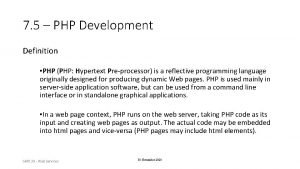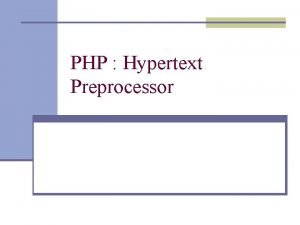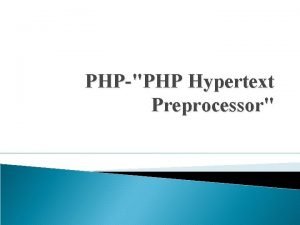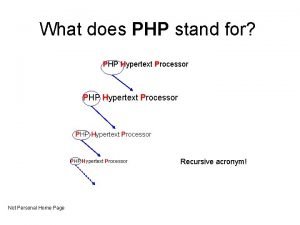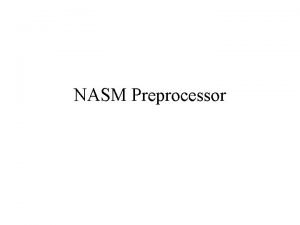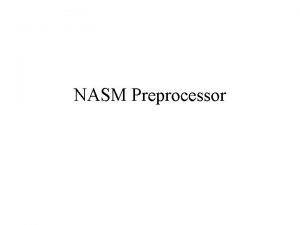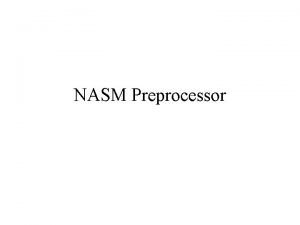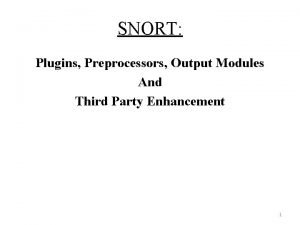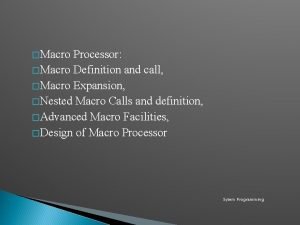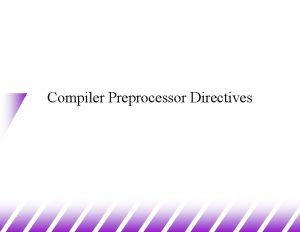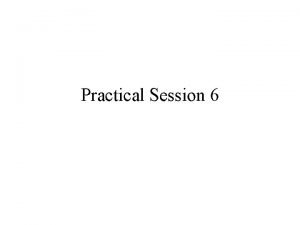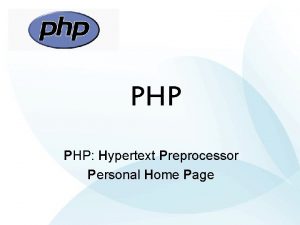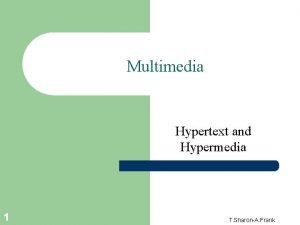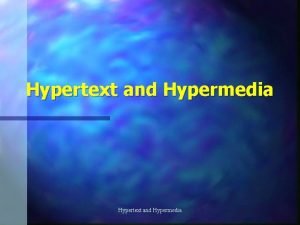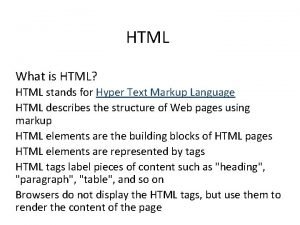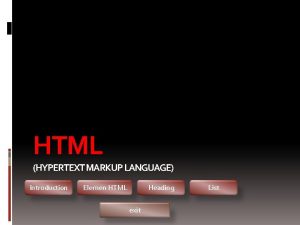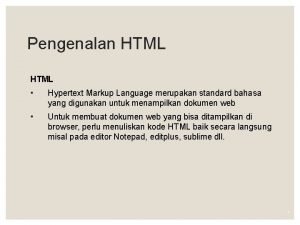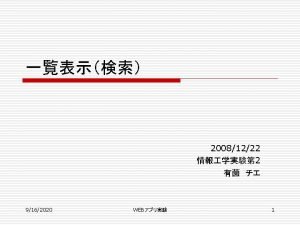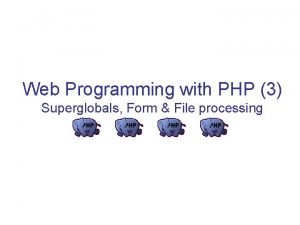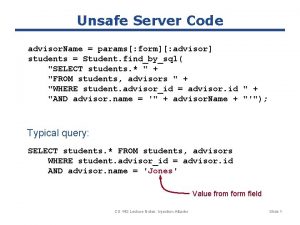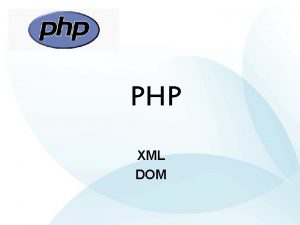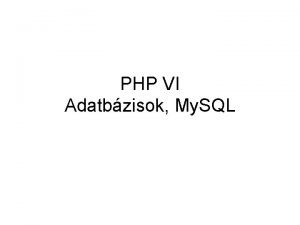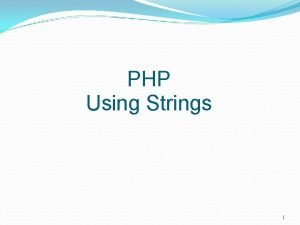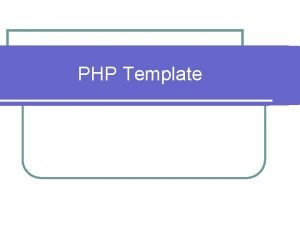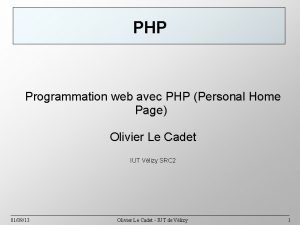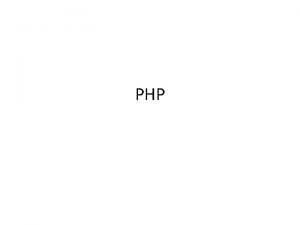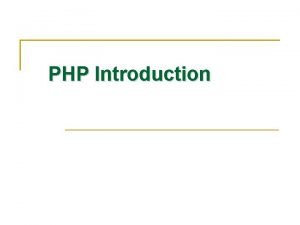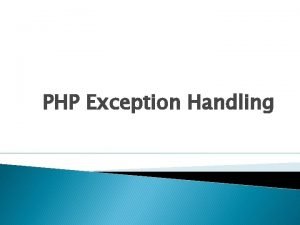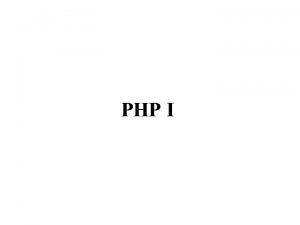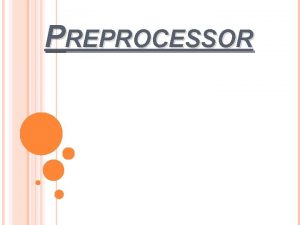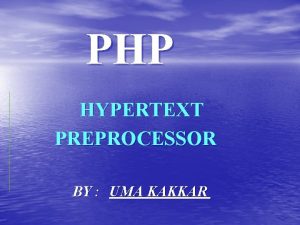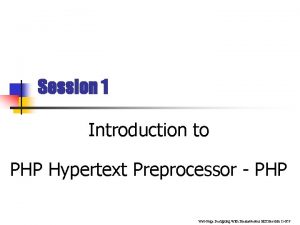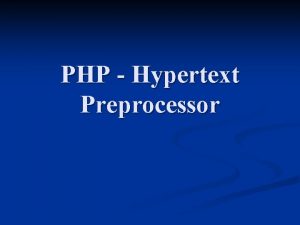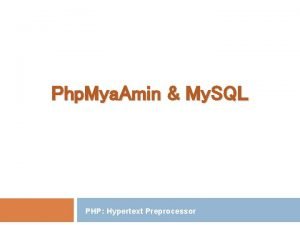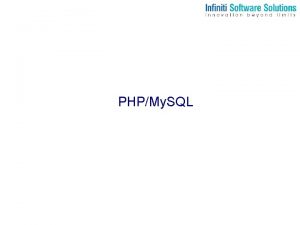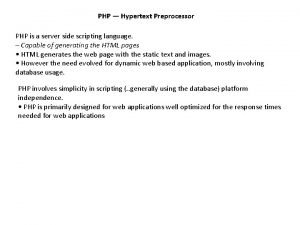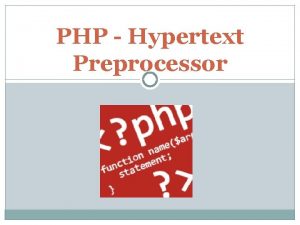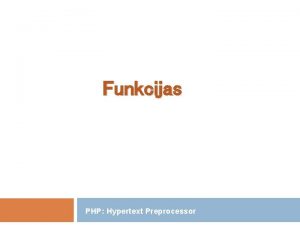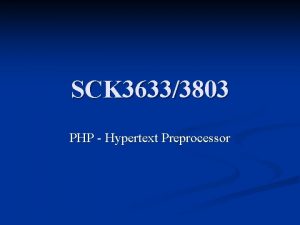INTRODUCTION WHAT IS PHP PHP Hypertext Preprocessor is

























































- Slides: 57

INTRODUCTION

WHAT IS PHP? PHP (Hypertext Preprocessor) is a widely-used open source general-purpose scripting language that is especially suited for web development and can be embedded into HTML.

EXAMPLE #1 AN INTRODUCTORY EXAMPLE • <!DOCTYPE HTML> <html> <head> <title>Example</title> </head> <body> <? php echo "Hi, I'm a PHP script!"; ? > </body> </html>

WHAT IS PHP? Instead of lots of commands to output HTML (as seen in C or Perl), PHP pages contain HTML with embedded code that does "something" (in this case, output "Hi, I'm a PHP script!"). The PHP code is enclosed in special start and end processing instructions <? php and ? > that allow you to jump into and out of "PHP mode. " What distinguishes PHP from something like client-side Java. Script is that the code is executed on the server, generating HTML which is then sent to the client. The client would receive the results of running that script, but would not know what the underlying code was.

WHAT IS PHP? • The best things in using PHP are that it is extremely simple for a newcomer, but offers many advanced features for a professional programmer. • Although PHP's development is focused on server-side scripting, you can do much more with it.

WHAT CAN PHP DO? • Anything. • PHP is mainly focused on server-side scripting, so you can do anything any other CGI program can do, such as: collect form data, generate dynamic page content, or send and receive cookies. But PHP can do much more.

CGI: COMMON GATEWAY INTERFACE • A CGI program is any program designed to accept and return data that conforms to the CGI specification. • The program could be written in any programming language, including C, Perl or Java. • CGI programs are the most common way for Web servers to interact dynamically with users. Many HTML pages that contain forms, for example, use a CGI program to process the form's data once it's submitted. • Another increasingly common way to provide dynamic feedback for Web users is to include scripts or programs that run on the user's machine rather than the Web server. These programs can be Java applets, Java scripts, or Active. X controls. These technologies are known collectively as client-side solutions, while the use of CGI is a server-side solution because the processing occurs on the Web server.

WHAT CAN PHP DO? • There are three main areas where PHP scripts are used: (1) Server-side scripting. This is the most traditional and main target field for PHP. You need three things to make this work: the PHP parser (CGI or server module), a web server and a web browser. You need to run the web server, with a connected PHP installation. You can access the PHP program output with a web browser, viewing the PHP page through the server. All these can run on your home machine if you are just experimenting with PHP programming.

WHAT CAN PHP DO? • There are three main areas where PHP scripts are used: (2) Command line scripting. You can make a PHP script to run it without any server or browser. You only need the PHP parser to use it this way. This type of usage is ideal for scripts regularly executed on Linux or on Windows. These scripts can also be used for simple text processing tasks.

WHAT CAN PHP DO? • There are three main areas where PHP scripts are used: (3) Writing desktop applications. PHP is probably not the very best language to create a desktop application with a graphical user interface, but if you know PHP very well, and would like to use some advanced PHP features in your client-side applications.

WHAT CAN PHP DO? • So with PHP, you have the freedom of choosing an operating system and a web server. With PHP you are not limited to output HTML. PHP's abilities includes outputting images, PDF files and even Flash movies (using libswf and Ming) generated on the fly. You can also output easily any text, such as XHTML and any other XML file. PHP can autogenerate these files, and save them in the file system, instead of printing it out, forming a server-side cache for your dynamic content. • One of the strongest and most significant features in PHP is its support for a wide range of databases. Writing a database-enabled web page is incredibly simple using one of the database specific extensions (e. g. , for mysql).

WHAT DO I NEED? • If your server supports PHP, then you do not need to do anything. Just create your. php files, put them in your web directory and the server will automatically parse them for you. There is no need to compile anything nor do you need to install any extra tools. • Think of these PHP-enabled files as simple HTML files with a whole new family of magical tags that let you do all sorts of things. • Let us say you want to save precious bandwidth and develop locally. In this case, you will want to install a web server, such as Apache, and of course PHP. You will most likely want to install a database as well, such as My. SQL.

GENERAL INSTALLATION CONSIDERATIONS • For the first and most common form, you need three things: PHP itself, a web server and a web browser. You probably already have a web browser, and depending on your operating system setup, you may also have a web server (e. g. Apache on Linux and Mac. OS X; IIS on Windows). 1) PHP 2) Web server (Apache) – Data Base (My. SQL) 3) Web Browser (Google Chrome) 4) Editor

PHP • Lamp Linux Apache, My. SQL, PHP • Mamp Mac Apache, My. SQL, PHP • Wamp. Server Windows Apache, My. SQL, PHP • Xampp All OS Apache, My. SQL, PHP, and PERL • Xampp download in Google • From Download XAMPP - Apache Friends

EDITOR • Komodo. IDE: Trial 30 days • Sublime. Text: • Netbeans: Free • Aptana. Studio: Free

• After setup Xampp, you will find a folder called xampp in the partition C. • C ------ xampp -----htdocs ( hypertext documents) ( pages that should be shown in local host).

BASIC SYNTAX PHP TAGS • When PHP parses a file, it looks for opening and closing tags, which are <? php and ? > which tell PHP to start and stop interpreting the code between them. • Parsing in this manner allows PHP to be embedded in all sorts of different documents, as everything outside of a pair of opening and closing tags is ignored by the PHP parser. • If a file is pure PHP code, it is preferable to omit the PHP closing tag at the end of the file. This prevents accidental whitespace or new lines being added after the PHP closing tag.

BASIC SYNTAX INSTRUCTION SEPARATION • As in C or Perl, PHP requires instructions to be terminated with a semicolon at the end of each statement. The closing tag of a block of PHP code automatically implies a semicolon; you do not need to have a semicolon terminating the last line of a PHP block. The closing tag for the block will include the immediately trailing newline if one is present. • <? php echo 'This is a test'; ? > <? php echo 'This is a test' ? > <? php echo 'We omitted the last closing tag';

COMMENTS • Message to everyone who reads source program and is used to document source code. • Makes the program more readable and eye catching. • Non executable statement. • Always neglected by compiler. • Can be written anywhere and any number of times. • Use as many comments as possible.

COMMENTS 1. Single Line Comment • starts with “//” symbol. • Remaining line after “//” symbol is ignored by browser. • End of Line is considered as End of the comment. 2. Multiple Line Comment (Block Comment) • starts with “/*” symbol. • ends with “*/” symbol.

COMMENTS • Example: <? php echo "This is a test"; // This is a one line comment /* This is a multiple line comment or block comment */ echo "Test again"; ? >

VARIABLES • PHP supports ten primitive types. • Four scalar types: • boolean • integer • float (floating-point number, aka double) • string

VARIABLES BOOLEAN • This is the simplest type. • A boolean expresses a truth value. • It can be either TRUE or FALASE. • Both are case-insensitive. • Example: <? php $status = True; // assign the value TRUE to $status ? >

VARIABLES INTEGER • An integer is a number of the set ℤ = {. . . , -2, -1, 0, 1, 2, . . . }. • Integers can be specified in decimal (base 10), hexadecimal (base 16), octal (base 8) or binary (base 2) notation, optionally preceded by a sign (- or +). • To use octal notation, precede the number with a 0 (zero). To use hexadecimal notation precede the number with 0 x. To use binary notation precede the number with 0 b. • <? php $a = 1234; // decimal number $a = -123; // a negative number $a = 0123; // octal number (equivalent to 83 decimal) $a = 0 x 1 A; // hexadecimal number (equivalent to 26 decimal) $a = 0 b 1111; // binary number (equivalent to 255 decimal) ? >

VARIABLES INTEGER • The size of an integer is platform-dependent, although a maximum value of about two billion is the usual value (that's 32 bits signed). • There is no integer division operator in PHP. 1/2 yields the float 0. 5. The value can be casted to an integer to round it towards zero, or the round() function provides finer control over rounding. • <? php var_dump(25/7); // float(3. 5714286) var_dump((int) (25/7)); // int(3) var_dump(round(25/7)); // float(4) ? >

VARIABLES FLOAT • Floating point numbers (also known as "floats", "doubles", or "real numbers") • It can be specified using any of the following syntaxes: • <? php $a = 1. 234; $b = 1. 2 e 3; $c = 7 E-10; ? >

VARIABLES STRING • A string is series of characters, where a character is the same as a byte. • A string literal can be specified in four different ways: • single quoted • double quoted • heredoc syntax • nowdoc syntax

VARIABLES STRING • single quoted • The simplest way to specify a string is to enclose it in single quotes (the character '). • To specify a literal single quote, escape it with a backslash (). To specify a literal backslash, double it (\). All other instances of backslash will be treated as a literal backslash: this means that the other escape sequences you might be used to, such as r or n, will be output literally as specified rather than having any special meaning.

VARIABLES STRING • single quoted • <? php echo 'this is a simple string'; // Outputs: Arnold once said: "I'll be back" echo 'Arnold once said: "I'll be back"'; // Outputs: You deleted C: *. *? echo 'You deleted C: \*. *? '; // Outputs: This will not expand: n a newline echo 'This will not expand: n a newline'; ? >

VARIABLES STRING • Double quoted • If the string is enclosed in double-quotes ("), PHP will interpret the following escape sequences for special characters: Escaped characters Sequence n t v \ $ " Meaning Linefeed horizontal tab vertical tab Backslash dollar sign double-quote

VARIABLES • Four compound types: • array • object • callable • iterable • And finally two special types: • resource • NULL

VARIABLES • Variables in PHP are represented by a dollar sign $ followed by the name of the variable. The variable name is case-sensitive. • Variable names follow the same rules as other labels in PHP. A valid variable name starts with a letter or underscore, followed by any number of letters, numbers, or underscores. • These are OK. $cost $str 17 $_tax $17 str $@^%! • but not these: value

VARIABLES • You can use them in the usual way. $total = $basic + $tax; • but you can also do some unusual things. What is printed when you run the following code? $h = "hello"; $var = "h"; echo $$var; Because $var has the value "h", PHP regards $$var as being the same thing as $h. So it prints the word hello.

• By default, variables are always assigned by value. That is to say, when you assign an expression to a variable, the entire value of the original expression is copied into the destination variable. This means, for instance, that after assigning one variable's value to another, changing one of those variables will have no effect on the other. • PHP also offers another way to assign values to variables: assign by reference. This means that the new variable simply references (in other words, "becomes an alias for" or "points to") the original variable. Changes to the new variable affect the original, and vice versa.

• To assign by reference, simply prepend an ampersand (&) to the beginning of the variable which is being assigned (the source variable). For instance, the following code snippet outputs 'My name is Bob' twice: • <? php $foo = 'Bob'; // Assign the value 'Bob' to $foo $bar = &$foo; // Reference $foo via $bar = "My name is $bar"; // Alter $bar. . . echo $bar; echo $foo; // $foo is altered too. ? >

• It is not necessary to initialize variables in PHP however it is a very good practice. Uninitialized variables have a default value of their type depending on the context in which they are used-booleans default to FALSE, integers and floats default to zero, strings (e. g. used in echo) are set as an empty string and arrays become to an empty array.

• Variable scope • The scope of a variable is the context within which it is defined. For the most part all PHP variables only have a single scope. • <? php $a = 1; /* global scope */ function test() { echo $a; /* reference to local scope variable */ } test(); ? >

• Variable scope • This script will not produce any output because the echo statement refers to a local version of the $a variable, and it has not been assigned a value within this scope. • In PHP global variables must be declared global inside a function if they are going to be used in that function.

• <? php $a = 1; $b = 2; function Sum() { global $a, $b; $b = $a + $b; } Sum(); echo $b; ? >

• The above script will output 3. By declaring $a and $b global within the function, all references to either variable will refer to the global version. • There is no limit to the number of global variables that can be manipulated by a function.

VARIABLES • Sometimes it is convenient to be able to have variable names. That is, a variable name which can be set and used dynamically. A normal variable is set with a statement such as: • <? php $a = 'hello'; ? >

VARIABLES • A variable takes the value of a variable and treats that as the name of a variable. In the above example, hello, can be used as the name of a variable by using two dollar signs. i. e. • <? php $$a = 'world'; ? >

VARIABLES • At this point two variables have been defined and stored in the PHP symbol tree: $a with cont • <? php echo "$a ${$a}"; ? >ents "hello" and$hello with contents "world". Therefore, this statement: • produces the exact same output as: • <? php echo "$a $hello"; ? > • i. e. they both produce: hello world.

CONSTANTS • A constant is an identifier (name) for a simple value. • As the name suggests, that value cannot change during the execution of the script. • A constant is case-sensitive by default. • The name of a constant follows the same rules as any label in PHP. • A valid constant name starts with a letter or underscore, followed by any number of letters, numbers, or underscores.

CONSTANTS • You can define a constant by using: • define() • const You can get the value of a constant by simply specifying its name. Unlike with variables, you should not prepend a constant with a $. You can also use the function constant() to read a constant's value if you wish to obtain the constant's name dynamically.

CONSTANTS - Differences between constants and variables: • Constants do not have a dollar sign ($) before them; • Constants may not be redefined or undefined once they have been set. • Example #1 Defining Constants • <? php define("CONSTANT", "Hello world. "); echo CONSTANT; // outputs "Hello world. " echo Constant; // outputs "Constant" and issues a notice. ? >

CONSTANTS Example #2 Defining Constants using the const keyword <? php // Works as of PHP 5. 3. 0 const CONSTANT = 'Hello World'; echo CONSTANT; // Works as of PHP 5. 6. 0 const ANOTHER_CONST = CONSTANT. '; Goodbye World'; echo ANOTHER_CONST; const ANIMALS = array('dog', 'cat', 'bird'); echo ANIMALS[1]; // outputs "cat"

MAGIC CONSTANTS PHP provides a large number of predefined constants to any script which it runs. Many of these constants, however, are created by various extensions, and will only be present when those extensions are available, either via dynamic loading or because they have been compiled in. There are nine magical constants that change depending on where they are used. For example, the value of _ _ LINE _ _ depends on the line that it's used on in your script. All these "magical" constants are resolved at compile time, unlike regular constants thats resolved at runtime. These special constants are case-insensitive

A FEW "MAGICAL" PHP CONSTANTS Name Description _ _LINE_ _ The current line number of the file. _ _FILE_ _ The full path and filename of the file with symlinks resolved. If used inside an include, the name of the included file is returned. _ _DIR_ _ The directory of the file. If used inside an include, the directory of the included file is returned. This is equivalent to dirname(__FILE__). This directory name does not have a trailing slash unless it is the root directory. _ _FUNCTION_ _ The function name.

OUTPUT • Output from a PHP script is HTML that is sent to the browser. • There are three ways to produce output: echo, print, and printf

EXPRESSIONS • Expressions are the most important building blocks of PHP. • In PHP, almost anything you write is an expression. • The simplest yet most accurate way to define an expression is "anything that has a value". • The most basic forms of expressions are constants and variables. When you type "$a = 5", you're assigning '5' into $a.

EXPRESSIONS • Another good example of expression orientation is pre- and post-increment and decrement. Users of PHP and many other languages may be familiar with the notation of variable++ and variable--. These are increment and decrement operators. • In PHP, like in C, there are two types of increment - pre-increment and post-increment. Both pre-increment and post-increment essentially increment the variable, and the effect on the variable is identical. • The difference is with the value of the increment expression. Pre-increment, which is written '++$variable', evaluates to the incremented value (PHP increments the variable before reading its value, thus the name 'pre-increment'). Post-increment, which is written '$variable++' evaluates to the original value of $variable, before it was incremented (PHP increments the variable after reading its value, thus the name 'post-increment').

EXPRESSIONS • A very common type of expressions are comparison expressions. These expressions evaluate to either FALSE or TRUE. • PHP supports: > (bigger than), >= (bigger than or equal to), == (equal), != (not equal), < (smaller than) and <= (smaller than or equal to). The language also supports a set of strict equivalence operators: === (equal to and same type) and !== (not equal to or not same type). • These expressions are most commonly used inside conditional execution, such as if statements.

EXPRESSIONS • Combined operator-assignment expressions. • Example: '$a += 3’. • This means "take the value of $a, add 3 to it, and assign it back into $a". • In addition to being shorter and clearer, this also results in faster execution. • Any two-place operator can be used in this operator-assignment mode, for example '$a -= 5' (subtract 5 from the value of $a), '$b *= 7' (multiply the value of $b by 7), etc.

EXPRESSIONS • There is one more expression that may seem odd if you haven't seen it in other languages, the ternary conditional operator: • <? php $first ? $second : $third ? > • If the value of the first subexpression is TRUE (non-zero), then the second subexpression is evaluated, and that is the result of the conditional expression. Otherwise, the third subexpression is evaluated, and that is the value.

EXPRESSIONS • <? php $b = $a = 5; /* assign the value five into the variable $a and $b */ $c = $a++; /* post-increment, assign original value of $a (5) to $c */ $e = $d = ++$b; /* pre-increment, assign the incremented value of $b (6) to $d and $e */ $f = double($d++); /* assign twice the value of $d before the increment, 2*6 = 12 to $f */ $g = double(++$e); /* assign twice the value of $e after the increment, 2*7 = 14 to $g */ $h = $g += 10; /* first, $g is incremented by 10 and ends with the value of 24. the value of the assignment (24) is then assigned into $h, and $h end s with the value of 24 as well. */ ? >

DATABASES • If you have XAMPP already installed, you should be able to follow along by going to localhost/phpmyadmin in your browser, while XAMPP is running. • http: //localhost/phpmyadmin
 Definition of php
Definition of php T.php
T.php Hypertext preprocessor meaning
Hypertext preprocessor meaning Php hypertext preprocessor
Php hypertext preprocessor Phpphp
Phpphp Php stand
Php stand Php stands for -
Php stands for - Hypertext processor
Hypertext processor Nasm preprocessor
Nasm preprocessor Nasm macros
Nasm macros Imacros infinite loop
Imacros infinite loop What is snort preprocessor
What is snort preprocessor What are different advanced macro preprocessor facilities?
What are different advanced macro preprocessor facilities? Preprocessor in compiler construction
Preprocessor in compiler construction Html preprocessor
Html preprocessor Nasm preprocessor
Nasm preprocessor Personal hypertext processor
Personal hypertext processor Hypermedia vs hypertext
Hypermedia vs hypertext Hypermedia vs hypertext
Hypermedia vs hypertext What is electronic text
What is electronic text Text tula
Text tula Patchwork girl hypertext
Patchwork girl hypertext Td vs th
Td vs th Hypertext and hypermedia
Hypertext and hypermedia What is html stands for? *
What is html stands for? * Format yang dipakai untuk membuat dokumen hypertext
Format yang dipakai untuk membuat dokumen hypertext Example of hypertext
Example of hypertext Hypertext
Hypertext Standar format untuk dokumen hypertext
Standar format untuk dokumen hypertext Hypertext vs hypermedia
Hypertext vs hypermedia Advantages of hypertext
Advantages of hypertext Hypertext significato
Hypertext significato Www.facebook.com.php
Www.facebook.com.php Php php://input
Php php://input Body paragraph structure
Body paragraph structure Ans
Ans Uhhttps://accessuh.uh.edu/login.php
Uhhttps://accessuh.uh.edu/login.php Php program
Php program Is php closed source
Is php closed source Steal .php?user_id = site:com
Steal .php?user_id = site:com Http://www.ducksters.com/science/electricity_uses.php
Http://www.ducksters.com/science/electricity_uses.php Pear http_request
Pear http_request Standard.php?menu=
Standard.php?menu= Php bramka sms
Php bramka sms Php xml dom
Php xml dom Php is an acronym for
Php is an acronym for Inurl:sql.php?id=
Inurl:sql.php?id= Php string length
Php string length Classification website template
Classification website template Snmpapp.conf
Snmpapp.conf /home.php
/home.php General.php?body=
General.php?body= What is outline
What is outline .php?my=”
.php?my=” Filter_validate
Filter_validate What is the recursive acronym for php?
What is the recursive acronym for php? Intro.php?aid=
Intro.php?aid= Throw exception php
Throw exception php
